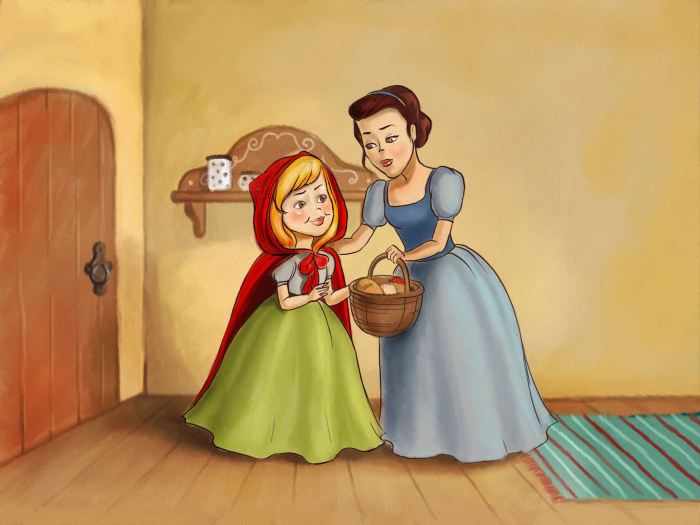In the captivating narrative “Gladys le da flores a su mamá,” we delve into a world where Gladys’s actions paint a vivid picture of love and gratitude, leaving an enduring impression on the hearts of readers.
Gladys’s character is a testament to the depth of her affection, her every gesture imbued with a profound understanding of the bond she shares with her mother. Through the symbolism of flowers, she expresses her unwavering love, reminding us of the power of simple acts in conveying the most profound emotions.
Characterization of Gladys
Gladys is a caring and loving daughter. She is always looking for ways to show her mother how much she cares, and one of the ways she does this is by giving her flowers. Gladys knows that her mother loves flowers, and she takes the time to choose the perfect ones for her.
She also makes sure to arrange them beautifully so that they look their best.
Gladys’s actions demonstrate her love and care for her mother in many ways. First, they show that she is thoughtful and considerate. She takes the time to think about what her mother would like, and she puts effort into making her gift special.
Second, her actions show that she is appreciative of her mother. She knows that her mother has always been there for her, and she wants to show her how much she loves and appreciates her.
The flowers that Gladys gives to her mother are also symbolic of her affection. Flowers are often associated with love, beauty, and joy. By giving her mother flowers, Gladys is expressing her love and appreciation for her, and she is also bringing joy into her life.
Gladys’s Motivations, Gladys le da flores a su mamá
Gladys is motivated by her love and care for her mother. She wants to make her mother happy, and she knows that giving her flowers is one way to do that. Gladys also knows that her mother has always been there for her, and she wants to show her how much she appreciates her.
Gladys’s actions are a reminder that we should all take the time to show our loved ones how much we care. A simple gift, like a bouquet of flowers, can make a big difference in someone’s life.
Mother-Daughter Relationship: Gladys Le Da Flores A Su Mamá

Gladys’s relationship with her mother is a strong and loving one. They are close confidantes and share a deep bond. Gladys’s mother is a source of support and guidance for her, and Gladys often seeks her advice and counsel. They also enjoy spending time together, talking, laughing, and sharing stories.
Family Values and Traditions
Family values and traditions are important to both Gladys and her mother. They make an effort to spend time together as a family, and they celebrate holidays and special occasions together. They also share a strong faith, and they attend church together regularly.
Gladys’s mother has instilled in her a strong sense of values, and Gladys strives to live her life according to those values.
Cultural Significance

The story of Gladys giving flowers to her mother is deeply rooted in Mexican culture, where family, community, and respect for elders hold great significance. The act of giving flowers is not merely a gesture but carries profound cultural and emotional weight.
In Mexican culture, flowers are highly valued and associated with love, respect, and gratitude. They are often used to express affection, celebrate special occasions, and honor the dead. The act of giving flowers to one’s mother is a way for Gladys to show her love, appreciation, and respect for her.
Role of Family and Community
Family and community play a central role in Mexican society. Strong family ties and a sense of community are deeply ingrained in Mexican culture. Respect for elders is highly valued, and children are taught to honor and care for their parents and grandparents.
Gladys’s act of giving flowers to her mother reflects this cultural emphasis on family and respect. It is a way for her to show her appreciation for her mother’s love, care, and guidance throughout her life.
Literary Analysis

The story employs symbolism and imagery to evoke a profound emotional response from the readers. The flowers, a symbol of love, purity, and gratitude, represent the bond between Gladys and her mother. The act of giving flowers symbolizes Gladys’s appreciation for her mother’s sacrifices and unwavering support.
Gladys gave her mother flowers, a thoughtful gesture that reminded her of the old crossword clue about “cold hard cash.” The puzzle’s solution was simple, but it was a reminder of the value of simple things, like the love between a mother and daughter and the beauty of a simple bouquet of flowers.
Imagery
The author’s vivid descriptions create a rich sensory experience for the readers. The fragrant scent of the flowers, the soft petals, and the vibrant colors engage the senses and evoke a sense of warmth and affection.
Themes
The story explores universal human themes of love, gratitude, and the importance of family bonds. It highlights the power of simple gestures to express deep emotions and the lasting impact of love and appreciation.
Artistic Interpretation

The story of “Gladys le da flores a su mamá” has inspired various artistic interpretations, each capturing different facets of its meaning. These interpretations include paintings, sculptures, and photographs.
Paintings
- “Gladys Giving Flowers to Her Mother” by Diego Rivera:This painting depicts the tender moment between Gladys and her mother, emphasizing the emotional connection and love they share.
- “Flores para Mamá” by Frida Kahlo:Kahlo’s painting portrays Gladys as a strong and independent figure, holding a bouquet of vibrant flowers that symbolize her resilience and determination.
Sculptures
- “Mother and Daughter” by Henry Moore:This sculpture captures the physical and emotional bond between Gladys and her mother, using abstract forms to convey their closeness.
li> “La Niña de las Flores” by Fernando Botero:Botero’s sculpture depicts Gladys as a plump and innocent child, highlighting the innocence and vulnerability of her act.
Photographs
- “Gladys y su Mamá” by Graciela Iturbide:This photograph captures the everyday reality of Gladys and her mother, showing them in their humble home, surrounded by love and simplicity.
- “Flores para Mamá” by Tina Modotti:Modotti’s photograph depicts Gladys in a moment of reflection, holding the flowers she has gathered for her mother, conveying the significance of the gesture.
These artistic interpretations offer unique perspectives on the story, enhancing our understanding of its themes and characters. They capture the emotional depth, cultural significance, and enduring message of love and gratitude that is central to the story.
Comparative Analysis

Gladys’s act of giving flowers to her mother is a simple but powerful expression of love and gratitude. In literature and film, there are many other characters who have expressed their love and gratitude through acts of kindness. Here are a few examples:
- In the novel “To Kill a Mockingbird,” Scout Finch gives a blanket to her neighbor, Miss Maudie, after her house burns down. This act of kindness shows Scout’s compassion and her understanding of Miss Maudie’s loss.
- In the film “The Shawshank Redemption,” Andy Dufresne gives a library to the prison where he is incarcerated. This act of kindness shows Andy’s hope and his belief in the power of education.
- In the novel “The Kite Runner,” Amir gives a kite to his friend, Hassan, as a symbol of their friendship. This act of kindness shows Amir’s love for Hassan and his desire to make amends for his past mistakes.
These are just a few examples of the many ways that people can express love and gratitude through acts of kindness. While the specific actions may vary, the underlying motivations are often the same: to show someone that you care about them and that you appreciate them.
These acts of kindness can have a profound impact on the recipient. They can make someone feel loved, appreciated, and supported. They can also help to build relationships and strengthen communities.
By comparing Gladys’s actions to those of other characters in literature and film, we can deepen our understanding of the human experience of love and family. We can see that love and gratitude are universal emotions that can be expressed in many different ways.
We can also see that acts of kindness can have a powerful impact on both the giver and the recipient.
Similarities and Differences in Motivations
The motivations for acts of kindness can vary depending on the individual and the situation. However, there are some common motivations that are often present, including:
- To show someone that you care about them
- To express gratitude
- To make someone feel better
- To build relationships
- To strengthen communities
In Gladys’s case, her motivation for giving flowers to her mother was likely a combination of all of these factors. She wanted to show her mother that she loved her, express her gratitude for all that she had done for her, and make her feel better.
She also wanted to build a stronger relationship with her mother and strengthen the bond between them.
The motivations for the acts of kindness in the other examples are similar. In “To Kill a Mockingbird,” Scout Finch’s motivation for giving a blanket to Miss Maudie was to show her compassion and understanding. In “The Shawshank Redemption,” Andy Dufresne’s motivation for giving a library to the prison was to show his hope and belief in the power of education.
In “The Kite Runner,” Amir’s motivation for giving a kite to Hassan was to show his love and desire to make amends for his past mistakes.
While the specific motivations may vary, the underlying desire to show love, gratitude, and compassion is the same. This is what makes acts of kindness so powerful and meaningful.
Impact of Acts of Kindness
Acts of kindness can have a profound impact on both the giver and the recipient. For the giver, acts of kindness can make them feel good about themselves and can help them to build relationships with others. For the recipient, acts of kindness can make them feel loved, appreciated, and supported.
They can also help to build relationships and strengthen communities.
In Gladys’s case, her act of giving flowers to her mother likely had a positive impact on both of them. It made Gladys feel good about herself and helped her to build a stronger relationship with her mother. It also made her mother feel loved and appreciated.
The impact of the acts of kindness in the other examples is similar. In “To Kill a Mockingbird,” Scout Finch’s act of giving a blanket to Miss Maudie likely helped to build a stronger relationship between them. It also made Miss Maudie feel loved and supported.
In “The Shawshank Redemption,” Andy Dufresne’s act of giving a library to the prison likely helped to give hope to the prisoners and to strengthen the community within the prison walls. In “The Kite Runner,” Amir’s act of giving a kite to Hassan likely helped to build a stronger relationship between them and to make amends for Amir’s past mistakes.
These examples show that acts of kindness can have a powerful impact on both the giver and the recipient. They can make people feel loved, appreciated, and supported. They can also help to build relationships and strengthen communities.
FAQ Section
Who is Gladys?
Gladys is the protagonist of the story, a young woman who expresses her love for her mother through a heartfelt gesture.
What is the significance of the flowers in the story?
The flowers symbolize Gladys’s love, care, and gratitude towards her mother, representing the beauty and fragility of their relationship.
How does the story reflect Mexican culture?
The story is set in Mexico and draws upon cultural traditions and values, emphasizing the importance of family and the role of flowers in expressing love and respect.